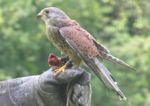Difference between revisions of "Avian Oral Cavity - Anatomy & Physiology"
Jump to navigation
Jump to search
| Line 1: | Line 1: | ||
| + | {{OpenPagesTop}} | ||
[[Image:Kestrel beak.jpg|thumb|right|150px|Beak of a kestrel - Copyright nabrown RVC]] | [[Image:Kestrel beak.jpg|thumb|right|150px|Beak of a kestrel - Copyright nabrown RVC]] | ||
==Introduction== | ==Introduction== | ||
| Line 18: | Line 19: | ||
}} | }} | ||
| + | {{OpenPages}} | ||
[[Category:Avian Alimentary System - Anatomy & Physiology]] | [[Category:Avian Alimentary System - Anatomy & Physiology]] | ||
[[Category:A&P Done]] | [[Category:A&P Done]] | ||
Revision as of 14:24, 28 June 2012
Introduction
In avian species, the lips and cheeks are replaced by the beak.
The beak is an area of dense, horny skin overlying the incisive bones of the mandible.
No modern birds possess teeth, however rudimentary enamel organs have been discovered in the embryos of some birds.
The size and structure of the avian tongue varies between species; it is related to the functional requirements of each species.
The avian hard palate contains a slit-like opening called the choanal opening which communicates with the nasal pharynx.
| Avian Oral Cavity - Anatomy & Physiology Learning Resources | |
|---|---|
 Test your knowledge using flashcard type questions |
Avian Alimentary Tract |
Error in widget FBRecommend: unable to write file /var/www/wikivet.net/extensions/Widgets/compiled_templates/wrt663c1f5d1c5f58_00102779 Error in widget google+: unable to write file /var/www/wikivet.net/extensions/Widgets/compiled_templates/wrt663c1f5d1fd7e7_99197691 Error in widget TwitterTweet: unable to write file /var/www/wikivet.net/extensions/Widgets/compiled_templates/wrt663c1f5d245384_09246027
|
| WikiVet® Introduction - Help WikiVet - Report a Problem |

